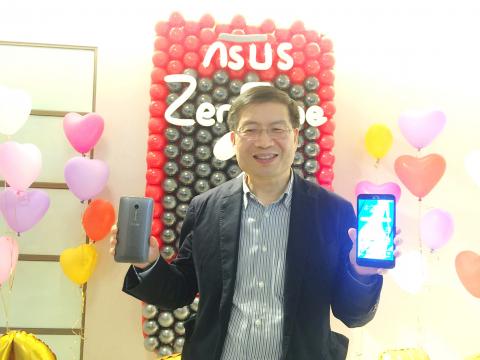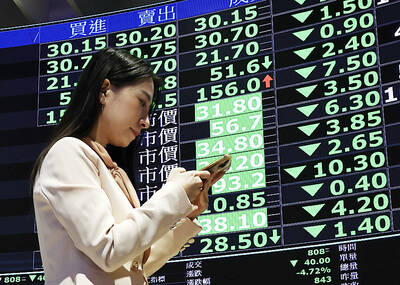Like most of its global competitors, such as Apple Inc, Asustek Computer Inc (華碩) is also counting on China to grow its new smartphone business and to hit its ambitious shipment target of 30 million units this year, more than tripling last year’s 8.5 million units.
Ahead of its official launch in Beijing today, the PC maker has about 2 million pre-sale orders for its latest flagship Zenfone 2 in China. That is a huge step for Asustek, which only sold between 600,000 and 700,000 smartphones in China last year.
“We hope the contribution from China will rise from last year’s 7 to 8 percent to 30 percent of total smartphone shipments this year,” Asustek chief executive Jerry Shen (沈振來) told reporters before a product launch in Beijing on March 27.

Photo: CNA
That translates into a shipment target of 9 million handsets in China this year.
China shipped a total of 420.7 million handsets last year, market researcher International Data Corp (IDC) said. Shipments are expected to grow 10 percent year-on-year to more than 462 million units this year, IDC said.
Asustek’s shipment target of 9 million units could help the firm gain nearly a 2 percent share of the Chinese market this year.
The company has raised its global smartphone shipments forecast three times in two months because of its optimism about the Chinese market.
At an investors’ conference in February, Shen said the smartphone business would become profitable when the firm ships more than 12 million units and that it expects to sell more than 17 million units by the end of this year.
During a Zenfone 2 product launch in Taiwan last month, Asustek chairman Jonney Shih (施崇棠) said the firm aims to triple its global smartphone shipments to 25 million units this year.
Two weeks later, Shih said he sees the company selling 30 million handsets this year.
Asustek chief financial officer David Chang (張偉明) told the Taipei Times that Shih raised the shipment target to 30 million units mainly because the company believes its new flagship product will be a great success in China.
“Zenfone 2 is the first and only smartphone that offers 4GB RAM globally. That unique spec has caught the eye of consumers,” Chang said, citing an enthusiastic response to the handsets in China, Taiwan and Europe.
Chang said 80 percent of global demand for the Zenfone 2 is for the 4GB RAM model, which is a good thing for the company because the model is priced higher and has a higher margin compared with the firm’s other handsets.
To gain a market share in China, Chang said Asustek last year launched the sub-brand Pegasus smartphone, which uses chips made by Qualcomm Inc and MediaTek Inc (聯發科), targeting the lower-priced segment of the market.
Expanding to the higher-priced segment this year, the company expects the mid-range 5.5-inch Zenfone 2, which is equipped with an Intel Corp processor, to complete a range of smartphones in the market and drive the firm’s sales performance, Chang said.
Generally, Intel processors cost more than those made by Qualcomm or MediaTek, but Intel is the only firm capable of making 4GB RAM available at the moment. Asustek plans to adopt Qualcomm’s processor when it is able to match Intel’s technology, Chang said.
The cost of the processor affects a smartphone’s price strategy and the product’s margin.
The Pegasus is priced between 899 yuan and 999 yuan (US$146 and US$163), while the Zenfone is priced at 2,000 yuan, the company said.
As part of its sales strategy, Asustek has partnered with Chinese telecoms to sell the Pegasus, while Zenfone 2 would be available via local retailers and online shopping sites, the company said.
At the end of last year, Asustek invited Chinese telecommunication equipment provider ZTE Corp’s (中興通訊) former vice president Wang Yong (王勇), who has wide experience with Chinese telecoms and retailers, to be Asustek’s deputy general manager for its Chinese smartphone business.
Asustek’s smartphone segment accounted for 17 percent of the firm’s total revenues of NT$477.4 billion (US$15.25 billion) last year, Shen said, adding that the company hopes the revenue contribution from the segment would grow to 30 percent this year on the back of growing demand in Taiwan and emerging markets.
“We hope the smartphone segment will account for more than 50 percent of our total sales by 2017, contributing more revenue than our PC products,” Shen said.

TARIFFS: The global ‘panic atmosphere remains strong,’ and foreign investors have continued to sell their holdings since the start of the year, the Ministry of Finance said The government yesterday authorized the activation of its NT$500 billion (US$15.15 billion) National Stabilization Fund (NSF) to prop up the local stock market after two days of sharp falls in reaction to US President Donald Trump’s new import tariffs. The Ministry of Finance said in a statement after the market close that the steering committee of the fund had been given the go-ahead to intervene in the market to bolster Taiwanese shares in a time of crisis. The fund has been authorized to use its assets “to carry out market stabilization tasks as appropriate to maintain the stability of Taiwan’s

STEEP DECLINE: Yesterday’s drop was the third-steepest in its history, the steepest being Monday’s drop in the wake of the tariff announcement on Wednesday last week Taiwanese stocks continued their heavy sell-off yesterday, as concerns over US tariffs and unwinding of leveraged bets weighed on the market. The benchmark TAIEX plunged 1,068.19 points, or 5.79 percent, to 17,391.76, notching the biggest drop among Asian peers as it hit a 15-month low. The decline came even after the government on late Tuesday authorized the NT$500 billion (US$15.2 billion) National Stabilization Fund (國安基金) to step in to buoy the market amid investors’ worries over tariffs imposed by US President Donald Trump. Yesterday’s decline was the third-steepest in its history, trailing only the declines of 2,065.87 points on Monday and

TARIFF CONCERNS: The chipmaker cited global uncertainty from US tariffs and a weakening economic outlook, but said its Singapore expansion remains on track Vanguard International Semiconductor Corp (世界先進), a foundry service provider specializing in producing power management and display driver chips, yesterday withdrew its full-year revenue projection of moderate growth for this year, as escalating US tariff tensions raised uncertainty and concern about a potential economic recession. The Hsinchu-based chipmaker in February said revenues this year would grow mildly from last year based on improving supply chain inventory levels and market demand. At the time, it also anticipated gradual quarter revenue growth. However, the US’ sweeping tariff policy has upended the industry’s supply chains and weakened economic prospects for the world economy, it said. “Now

Six years ago, LVMH’s billionaire CEO Bernard Arnault and US President Donald Trump cut the blue ribbon on a factory in rural Texas that would make designer handbags for Louis Vuitton, one of the world’s best-known luxury brands. However, since the high-profile opening, the factory has faced a host of problems limiting production, 11 former Louis Vuitton employees said. The site has consistently ranked among the worst-performing for Louis Vuitton globally, “significantly” underperforming other facilities, said three former Louis Vuitton workers and a senior industry source, who cited internal rankings shared with staff. The plant’s problems — which have not